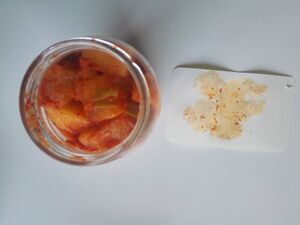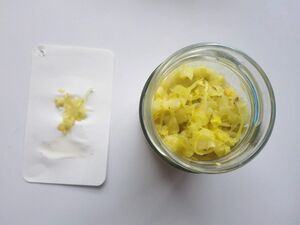Toward a Minor Tech:MagdaTC 500: Difference between revisions
No edit summary |
m (included in-text bold formatting) |
||
| Line 7: | Line 7: | ||
Magdalena Tyżlik-Carver | Magdalena Tyżlik-Carver | ||
Jar is a broad-mouthed container, usually cylindrical and made of glass or earthenware | '''Jar''' is a broad-mouthed container, usually cylindrical and made of glass or earthenware. | ||
I look at my jars of different shapes and sizes, made of glass. I use bigger ones to start the process of fermentation and smaller jars for storage of ferments, until I open them to eat. | |||
These fermenting jars are locations. Sites of life-sustaining chemical reactions that generate energy. You can watch how cabbages ferment. Salt insures that this is a non-hostile environment for good bacteria to proliferate. We can’t see these microscopic organisms with a naked eye, but we know they are there. In millions. I can smell the change they provoke. Soon enough it is possible to taste it too. Strong and sour; familiar odour hitting my nostrils briefly as I open the jar to release the gas. Later, I can smell its freshness too. | My fermenting jars contain fermenting plant matter, usually variety of cabbages but also other vegetables and plants such as carrots, garlic, variety of onions, daikon radish, and ramson leaves. There are also various spices, seeds and roots: ginger, turmeric, fennel seeds, gochugaru powder. I add salt. Water comes from vegetables in krauts. If I have to take it from a tap, I boil it and wait to cool before adding to the jar to submerge the veg. | ||
These fermenting jars are '''locations.''' | |||
Sites of life-sustaining chemical reactions that generate energy. You can watch how cabbages ferment. Salt insures that this is a non-hostile environment for good bacteria to proliferate. We can’t see these microscopic organisms with a naked eye, but we know they are there. In millions. I can smell the change they provoke. Soon enough it is possible to taste it too. Strong and sour; familiar odour hitting my nostrils briefly as I open the jar to release the gas. Later, I can smell its freshness too. | |||
Once eaten, their work moves to my gut supporting my digestion, boosting bioavailability of nutrients, and my body’s healthy inflammatory response. What could be the good work that can be done while living the good life supported by microbes and fermentation? | |||
[[File:Kraut.jpg|thumb|kraut in a jar]] | [[File:Kraut.jpg|thumb|kraut in a jar]] | ||
Fermentation defines a metabolic process where under specific conditions (in this case no oxygen) microbes create energy, alcohol and lactic acid from sugar and starch. Some say that in its most basic fermentation is a controlled decay. Lyn Margulis and Dorion Sagan (1997), scientists and a researchers of microbial forms, defined fermentation as a microbial invention, ancient biotechnology, and an unprecedented feat that humanity has not matched. Together with photosynthesis, oxygen breathing and removal of nitrogen from the air, fermentation is a miniature chemical system, that has been part of the making of this planet. | '''Fermentation''' defines a metabolic process where under specific conditions (in this case no oxygen) microbes create energy, alcohol and lactic acid from sugar and starch. Some say that in its most basic fermentation is a controlled decay. Lyn Margulis and Dorion Sagan (1997), scientists and a researchers of microbial forms, defined fermentation as a microbial invention, ancient biotechnology, and an unprecedented feat that humanity has not matched. Together with photosynthesis, oxygen breathing and removal of nitrogen from the air, fermentation is a miniature chemical system, that has been part of the making of this planet. | ||
Plant, minerals, microbes and I. We create patterns, in time, in bodies, in places. We inhabit each other while also being part of other configurations. At home, at work or school, on the street, in a jar, in the garden, in the city, on social media platforms. What are the patterns of good life there? What is the good work that is done there? Who does it and under what conditions? And for whom? | '''Plant''', '''minerals''', '''microbes''' and '''I'''. We create patterns, in time, in bodies, in places. We inhabit each other while also being part of other configurations. At home, at work or school, on the street, in a jar, in the garden, in the city, on social media platforms. What are the patterns of '''good life''' there? What is the '''good work''' that is done '''there'''? Who does it and under what conditions? And '''for whom'''? | ||
See: https://fermentingdata.net/ | See: https://fermentingdata.net/ | ||
Margulis, Lynn, and Dorion Sagan. ''Microcosmos: Four Billion Years of Evolution from Our Microbial Ancestors''. University of California Press, 1997. | Margulis, Lynn, and Dorion Sagan. ''Microcosmos: Four Billion Years of Evolution from Our Microbial Ancestors''. University of California Press, 1997. | ||
Revision as of 13:14, 20 January 2023
Fermenting Data Journal -
Magdalena Tyżlik-Carver
Jar is a broad-mouthed container, usually cylindrical and made of glass or earthenware.
I look at my jars of different shapes and sizes, made of glass. I use bigger ones to start the process of fermentation and smaller jars for storage of ferments, until I open them to eat.
My fermenting jars contain fermenting plant matter, usually variety of cabbages but also other vegetables and plants such as carrots, garlic, variety of onions, daikon radish, and ramson leaves. There are also various spices, seeds and roots: ginger, turmeric, fennel seeds, gochugaru powder. I add salt. Water comes from vegetables in krauts. If I have to take it from a tap, I boil it and wait to cool before adding to the jar to submerge the veg.
These fermenting jars are locations.
Sites of life-sustaining chemical reactions that generate energy. You can watch how cabbages ferment. Salt insures that this is a non-hostile environment for good bacteria to proliferate. We can’t see these microscopic organisms with a naked eye, but we know they are there. In millions. I can smell the change they provoke. Soon enough it is possible to taste it too. Strong and sour; familiar odour hitting my nostrils briefly as I open the jar to release the gas. Later, I can smell its freshness too.
Once eaten, their work moves to my gut supporting my digestion, boosting bioavailability of nutrients, and my body’s healthy inflammatory response. What could be the good work that can be done while living the good life supported by microbes and fermentation?
Fermentation defines a metabolic process where under specific conditions (in this case no oxygen) microbes create energy, alcohol and lactic acid from sugar and starch. Some say that in its most basic fermentation is a controlled decay. Lyn Margulis and Dorion Sagan (1997), scientists and a researchers of microbial forms, defined fermentation as a microbial invention, ancient biotechnology, and an unprecedented feat that humanity has not matched. Together with photosynthesis, oxygen breathing and removal of nitrogen from the air, fermentation is a miniature chemical system, that has been part of the making of this planet.
Plant, minerals, microbes and I. We create patterns, in time, in bodies, in places. We inhabit each other while also being part of other configurations. At home, at work or school, on the street, in a jar, in the garden, in the city, on social media platforms. What are the patterns of good life there? What is the good work that is done there? Who does it and under what conditions? And for whom?
See: https://fermentingdata.net/
Margulis, Lynn, and Dorion Sagan. Microcosmos: Four Billion Years of Evolution from Our Microbial Ancestors. University of California Press, 1997.

